2018年app开发的心得体会-word范文 (13页)
软件开发心得体会范文
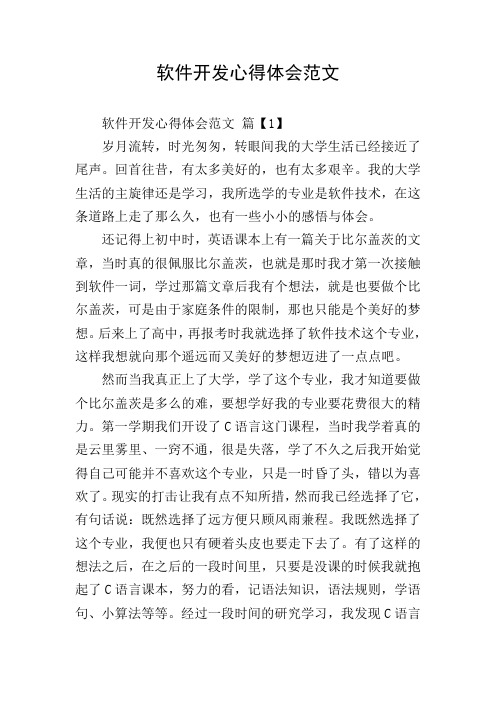
软件开发心得体会范文软件开发心得体会范文篇【1】岁月流转,时光匆匆,转眼间我的大学生活已经接近了尾声。
回首往昔,有太多美好的,也有太多艰辛。
我的大学生活的主旋律还是学习,我所选学的专业是软件技术,在这条道路上走了那么久,也有一些小小的感悟与体会。
还记得上初中时,英语课本上有一篇关于比尔盖茨的文章,当时真的很佩服比尔盖茨,也就是那时我才第一次接触到软件一词,学过那篇文章后我有个想法,就是也要做个比尔盖茨,可是由于家庭条件的限制,那也只能是个美好的梦想。
后来上了高中,再报考时我就选择了软件技术这个专业,这样我想就向那个遥远而又美好的梦想迈进了一点点吧。
然而当我真正上了大学,学了这个专业,我才知道要做个比尔盖茨是多么的难,要想学好我的专业要花费很大的精力。
第一学期我们开设了C语言这门课程,当时我学着真的是云里雾里、一窍不通,很是失落,学了不久之后我开始觉得自己可能并不喜欢这个专业,只是一时昏了头,错以为喜欢了。
现实的打击让我有点不知所措,然而我已经选择了它,有句话说:既然选择了远方便只顾风雨兼程。
我既然选择了这个专业,我便也只有硬着头皮也要走下去了。
有了这样的想法之后,在之后的一段时间里,只要是没课的时候我就抱起了C语言课本,努力的看,记语法知识,语法规则,学语句、小算法等等。
经过一段时间的研究学习,我发现C语言并没有我想象中的那么难了,还是很有意思的。
就这样在学与玩中我的大学第一个星期就过完了。
后来又开设了很多课程,有VB、网络、数据库、操作系统、数据结构等。
在这些课程中最令我头疼的就是数据库了,老师讲的时候老是划重点,讲的很少,当时学的时候真的好难受,一学期下来啥也不会,后来看书上的操作,一步一步的操作,才终于学会了建个数据库,做下备份还原等操作。
开设的那么多课程也有我很喜欢的课程,比如数据结构,这门课程理论的比较多,上机操作的很少,这门课程是很需要理解的,当然有的还是要死记的。
学习这门课的时候,我觉得并不像其它课程那么吃力,可能高中是学理科的缘故吧,理解起来并不太费劲。
软件开发心得体会

软件开发心得体会在过去的几年里,我一直在软件开发方面工作。
在这段时间里,我学到了很多东西,也遇到了许多挑战,这让我对这个领域有了更深入的理解和认识。
在这篇文章中,我想分享我的一些心得体会,并希望能对即将进入这个领域的人提供帮助。
首先,我想说的是,软件开发并不仅仅是写代码。
它涉及到了很多不同的方面,例如项目管理、需求分析、软件架构、测试和质量保证等等。
如果你想要成功地完成一个项目,你需要了解并掌握这些方面。
其次,我认为在软件开发中,沟通是非常重要的。
无论你是与客户、团队成员或项目经理交流,清晰明了的沟通将有助于确保项目的成功。
在与他人交流时,要注意形式和方式,以确保传达的信息准确无误。
另一个方面,我学到的是“迭代式开发”是一种非常有效的开发方式。
与传统的“瀑布式开发”相比,迭代式开发更加具有灵活性,可以更好地适应不断变化的需求。
在每个迭代周期结束时,反馈都会被收集和整理,这有助于及时纠正错误和改进软件功能。
同时,我还意识到在软件开发中,代码规范是至关重要的。
遵守一定的规范,有助于提高代码可读性、可维护性和可扩展性。
良好的代码规范还能够在团队合作时统一代码风格,提高代码协作质量。
最后,我想说的是,志同道合的人会一起走得更远。
软件开发是一个需要团队合作的行业,没有哪个人可以独自完成一项大型项目。
因此,你需要与团队成员建立良好的合作关系,互相支持和帮助。
总之,软件开发是一个充满挑战的领域。
在这个过程中,你需要掌握各种技能和技术,包括沟通、项目管理、软件架构和代码规范。
通过不断的实践和经验积累,你会不断提高自己的技能和知识,成为一个更优秀的软件开发人员。
app开发实训心得(优质17篇)
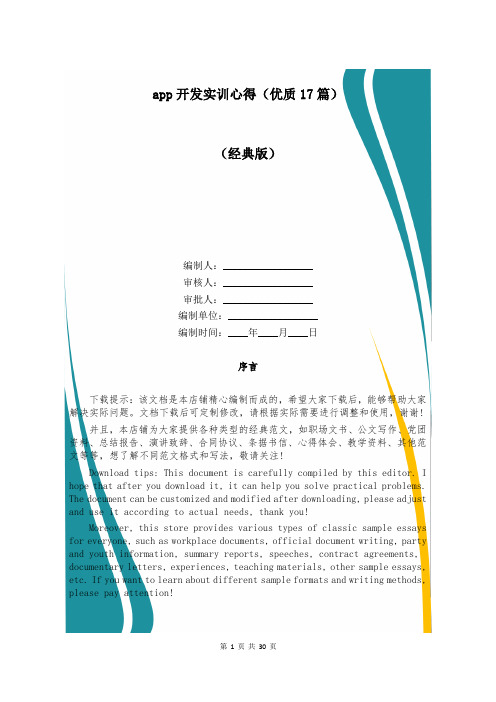
app开发实训心得(优质17篇)(经典版)编制人:__________________审核人:__________________审批人:__________________编制单位:__________________编制时间:____年____月____日序言下载提示:该文档是本店铺精心编制而成的,希望大家下载后,能够帮助大家解决实际问题。
文档下载后可定制修改,请根据实际需要进行调整和使用,谢谢!并且,本店铺为大家提供各种类型的经典范文,如职场文书、公文写作、党团资料、总结报告、演讲致辞、合同协议、条据书信、心得体会、教学资料、其他范文等等,想了解不同范文格式和写法,敬请关注!Download tips: This document is carefully compiled by this editor. I hope that after you download it, it can help you solve practical problems. The document can be customized and modified after downloading, please adjust and use it according to actual needs, thank you!Moreover, this store provides various types of classic sample essays for everyone, such as workplace documents, official document writing, party and youth information, summary reports, speeches, contract agreements, documentary letters, experiences, teaching materials, other sample essays, etc. If you want to learn about different sample formats and writing methods, please pay attention!app开发实训心得(优质17篇)心得体会是在自己经历某个事件或完成某项任务之后,对所得到的经验和教训进行总结和思考的一种表达方式。
实习报告:我在软件开发实习中的体验与感悟

实习报告:我在软件开发实习中的体验与感悟一、实习前的准备工作进入大学的第二年,我决定找一份与专业相关的实习来提升自己。
经过一番搜索和咨询,我选择了软件开发实习。
在正式开始实习之前,我进行了一些准备工作。
首先,我重新温习了计算机基础知识,包括数据结构、算法和编程语言等方面。
其次,我参加了一些面向实习的培训课程,学习了一些实用的开发技能。
最后,我也积极寻找实习机会,投递了简历并参加了一些面试。
二、实习内容和任务在我的软件开发实习中,我加入了一家知名软件公司的开发团队。
我所在的团队主要负责开发一款新的移动应用程序。
我的导师是一位经验丰富的软件工程师,他帮助我了解了整个开发流程,并指导我完成了一些小任务。
实习期间,我主要负责开发和调试一些界面模块以及功能模块,并与其他团队成员进行协同工作。
这些任务对我来说非常有挑战性,但也给了我很多学习和成长的机会。
三、实习中的挑战和困难在实习中,我遇到了许多挑战和困难。
首先,作为一个实习生,我对开发流程和工具不够熟悉,需要花费一些时间去学习和适应。
其次,项目所使用的技术栈对我来说比较新,我需要通过自学和与团队成员的交流来快速掌握。
另外,由于项目的进度较快,我需要面对较高的工作压力,需要更加高效地完成任务。
四、实习中的收获和成长通过这次软件开发实习,我获得了许多宝贵的收获和成长。
首先,我学会了更加高效地使用开发工具和技术,提高了自己的开发能力和代码质量。
其次,我通过与导师和其他团队成员的合作,锻炼了我的团队合作能力和沟通能力。
此外,实习还给我提供了一个真实的工作环境,让我更好地理解了软件开发行业的工作方式和流程。
五、实习中的体会和感想在实习中,我深刻感受到了软件开发的魅力和挑战。
软件开发不仅需要技术的支撑,还需要团队的协作和沟通能力。
在解决问题的过程中,我学会了更加细致地思考和分析,培养了解决问题的能力。
同时,我也明白了学习的重要性,只有不断学习和适应新的技术,才能在这个快速发展的行业中立于不败之地。
软件开发反思总结范文

在过去的软件开发过程中,我经历了许多挑战和成长。
回顾这段时间,我深刻认识到自己在技术、团队协作和项目管理等方面的不足,同时也收获了许多宝贵的经验和教训。
以下是我对这段时间的反思总结。
一、技术方面的反思1. 技术深度不足在软件开发过程中,我意识到自己在技术深度方面存在不足。
虽然掌握了多种编程语言和框架,但对某些技术原理和算法了解不够深入。
这导致在遇到复杂问题时,难以快速找到解决方案。
因此,在今后的工作中,我将加强技术积累,深入学习相关技术原理,提高自己的技术深度。
2. 编码规范问题在编写代码时,我发现自己存在一些编码规范问题。
如命名不规范、注释不清晰、代码重复等。
这些问题不仅影响代码的可读性,还可能导致后期维护困难。
为了提高代码质量,我将在今后的工作中严格遵守编码规范,提高自己的编程水平。
二、团队协作方面的反思1. 沟通不畅在团队协作过程中,我发现自己在沟通方面存在一定问题。
有时,由于表达不清或沟通不及时,导致团队成员之间产生误解,影响项目进度。
为了改善这一问题,我将在今后的工作中加强沟通,提高自己的表达能力。
2. 团队协作意识不足在团队项目中,我意识到自己团队协作意识不足。
有时,为了追求个人进度,忽视了与其他成员的协作。
为了提高团队整体效率,我将在今后的工作中加强团队协作意识,积极与其他成员沟通交流。
三、项目管理方面的反思1. 时间管理能力不足在项目管理过程中,我发现自己在时间管理方面存在不足。
有时,由于对项目进度估计不准确,导致项目延期。
为了提高时间管理能力,我将在今后的工作中合理规划时间,确保项目按时完成。
2. 风险控制能力不足在项目开发过程中,我意识到自己在风险控制方面存在不足。
有时,由于对潜在风险预估不足,导致项目出现严重问题。
为了提高风险控制能力,我将在今后的工作中加强对项目风险的识别和评估,提前制定应对措施。
总结:通过这段时间的软件开发工作,我认识到自己在技术、团队协作和项目管理等方面还存在诸多不足。
app开发心得体会

app开发心得体会在过去的几年里,我一直从事着app开发工作。
这一段时间不仅让我收获了技术上的成长,还让我深刻地认识到app开发的挑战和乐趣。
下面是我在app开发中的一些心得体会。
首先,我发现在app开发中,了解用户需求是至关重要的。
在项目初始阶段,我们要与用户进行充分的沟通和交流,了解他们的使用场景和期望,以便能够设计出合适的功能和界面。
这样做不仅能帮助我们开发出让用户满意的app,还能减少后期的调整和修改。
其次,代码质量对于app的稳定性和性能至关重要。
一开始,我意识到编写可维护和可扩展的代码是十分重要的。
尽管在快速迭代的开发过程中有时候会着急上线,但是只要投入足够的精力来优化代码,就能够减少后期的维护和改进工作,并提高app的稳定性和性能。
另外,在app开发中,团队合作也是非常重要的。
一个好的团队应该有清晰的沟通渠道和合理的分工合作。
每个团队成员都应该清楚自己的任务和目标,并且能够及时地向团队沟通和交流。
除此之外,及时的代码审查和单元测试也是保证代码质量的重要手段。
此外,app开发过程中的测试和迭代也是可以提高app质量的关键环节。
在开发过程中,我们应该始终保持测试的心态,包括单元测试、集成测试和验收测试等。
这样能够帮助我们及时发现和修复bug,提高app的稳定性和用户体验。
同时,测试也是我们了解用户反馈和需求的有力手段,只有通过反复的迭代和改进,才能真正开发出好的app。
最后,我认为app开发是一项需要不断学习和提升的工作。
在技术日新月异的今天,我们不能停留在过去的技术上,要不断学习新的技术和工具,跟上时代的步伐。
同时,我们也应该关注行业的动态和用户的需求,及时调整和优化自己的app,以满足用户不断变化的需求。
综上所述,app开发是一项既具有挑战性又有乐趣的工作。
通过与用户的沟通、优化代码质量、团队合作、测试和迭代以及不断学习和提升,我们可以不断提高自己的能力和开发出更好的app。
希望我的心得体会能够对那些从事或者将要从事app 开发的人有所帮助。
11月软件开发心得体会范文 (2)
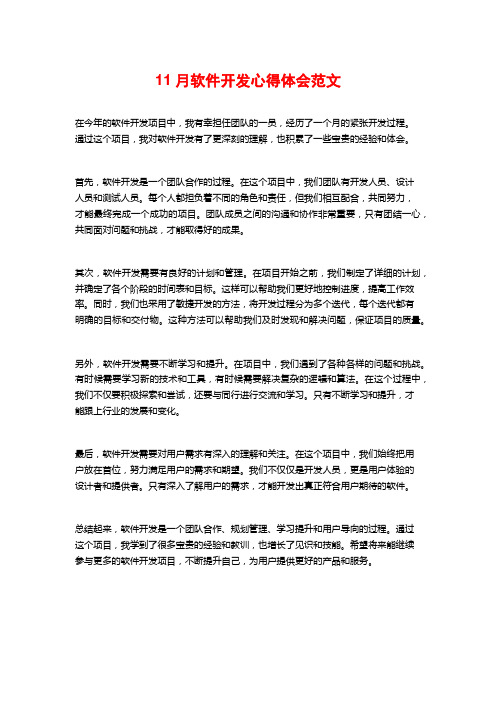
11月软件开发心得体会范文在今年的软件开发项目中,我有幸担任团队的一员,经历了一个月的紧张开发过程。
通过这个项目,我对软件开发有了更深刻的理解,也积累了一些宝贵的经验和体会。
首先,软件开发是一个团队合作的过程。
在这个项目中,我们团队有开发人员、设计人员和测试人员。
每个人都担负着不同的角色和责任,但我们相互配合,共同努力,才能最终完成一个成功的项目。
团队成员之间的沟通和协作非常重要,只有团结一心,共同面对问题和挑战,才能取得好的成果。
其次,软件开发需要有良好的计划和管理。
在项目开始之前,我们制定了详细的计划,并确定了各个阶段的时间表和目标。
这样可以帮助我们更好地控制进度,提高工作效率。
同时,我们也采用了敏捷开发的方法,将开发过程分为多个迭代,每个迭代都有明确的目标和交付物。
这种方法可以帮助我们及时发现和解决问题,保证项目的质量。
另外,软件开发需要不断学习和提升。
在项目中,我们遇到了各种各样的问题和挑战。
有时候需要学习新的技术和工具,有时候需要解决复杂的逻辑和算法。
在这个过程中,我们不仅要积极探索和尝试,还要与同行进行交流和学习。
只有不断学习和提升,才能跟上行业的发展和变化。
最后,软件开发需要对用户需求有深入的理解和关注。
在这个项目中,我们始终把用户放在首位,努力满足用户的需求和期望。
我们不仅仅是开发人员,更是用户体验的设计者和提供者。
只有深入了解用户的需求,才能开发出真正符合用户期待的软件。
总结起来,软件开发是一个团队合作、规划管理、学习提升和用户导向的过程。
通过这个项目,我学到了很多宝贵的经验和教训,也增长了见识和技能。
希望将来能继续参与更多的软件开发项目,不断提升自己,为用户提供更好的产品和服务。
软件开发实习心得体会(16篇)
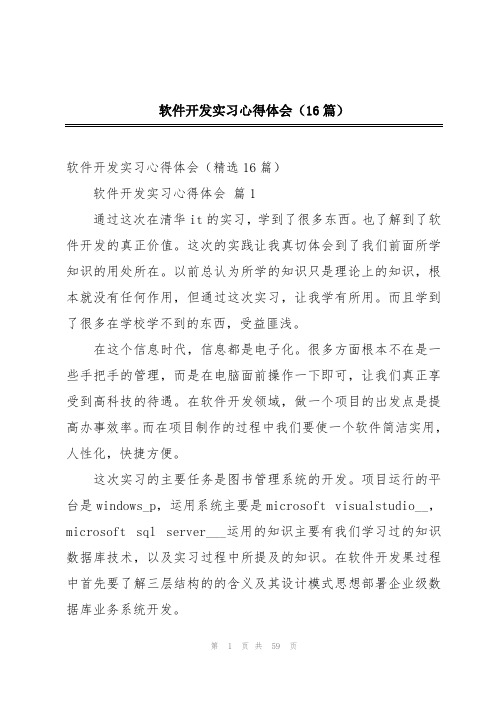
软件开发实习心得体会(16篇)软件开发实习心得体会(精选16篇)软件开发实习心得体会篇1通过这次在清华it的实习,学到了很多东西。
也了解到了软件开发的真正价值。
这次的实践让我真切体会到了我们前面所学知识的用处所在。
以前总认为所学的知识只是理论上的知识,根本就没有任何作用,但通过这次实习,让我学有所用。
而且学到了很多在学校学不到的东西,受益匪浅。
在这个信息时代,信息都是电子化。
很多方面根本不在是一些手把手的管理,而是在电脑面前操作一下即可,让我们真正享受到高科技的待遇。
在软件开发领域,做一个项目的出发点是提高办事效率。
而在项目制作的过程中我们要使一个软件简洁实用,人性化,快捷方便。
这次实习的主要任务是图书管理系统的开发。
项目运行的平台是windows_p,运用系统主要是microsoft visualstudio__,microsoft sql server___运用的知识主要有我们学习过的知识数据库技术,以及实习过程中所提及的知识。
在软件开发果过程中首先要了解三层结构的的含义及其设计模式思想部署企业级数据库业务系统开发。
三层结构是一种成熟、简单并得到普遍应用的应用程序架构,它将应用程序结构划分三层独立的包,包括用户表示层、业务逻辑层、数据访问层。
其中将实现人机界面的所有表单和组件放在表示层,将所有业务规则和逻辑的实现封装在负责业务逻辑组件中,将所有和数据库的交互封装在数据访问组件中。
三层结构示意图三层结构是一种严格分层方法,即数据访问层只能被业务逻辑层访问,业务逻辑层只能被表示层访问,用户通过表示层将请求传送给业务逻辑层,业务逻辑层完成相关业务规则和逻辑,并通过数据访问层访问数据库获得数据,然后按照相反的顺序依次返回将数据显示在表示层。
下面介绍图书管理系统开发技术一系统的功能设计首先对系统进行需求分析,我们必须要知道要做一个系统“用来干什么”,这需要在对用户需求进行充分调研的基础上,深入理解并描述出软件的功能、性能、接口等方面的需求,可以使用uml建模作为需求分析和系统设计的有效方法。
做手机软件的心得体会5篇精选案例

做手机软件的心得体会5篇精选案例(经典版)编制人:__________________审核人:__________________审批人:__________________编制单位:__________________编制时间:____年____月____日序言下载提示:该文档是本店铺精心编制而成的,希望大家下载后,能够帮助大家解决实际问题。
文档下载后可定制修改,请根据实际需要进行调整和使用,谢谢!并且,本店铺为大家提供各种类型的经典范文,如演讲致辞、总结报告、心得体会、合同协议、条据文书、策划方案、导游词、教学资料、作文大全、其他范文等等,想了解不同范文格式和写法,敬请关注!Download tips: This document is carefully compiled by this editor. I hope that after you download it, it can help you solve practical problems. The document can be customized and modified after downloading, please adjust and use it according to actual needs, thank you!Moreover, our store provides various types of classic sample essays for everyone, such as speeches, summary reports, insights, contract agreements, documentary evidence, planning plans, tour guides, teaching materials, complete essays, and other sample essays. If you want to learn about different formats and writing methods of sample essays, please stay tuned!做手机软件的心得体会5篇精选案例手机APP的广泛使用作为移动互联的快速发展的一部分,展现出了它不同于传统PC软件的巨大的优势。
app开发的反思收获个人角度

app开发的反思收获个人角度
首先,非常感谢起步软件提供一个这么方便的跨平台移动开发工具。
我是从web开发转到app开发的。
WeX5非常容易入门,提供了大量的视频,但是帮助文档不是很齐全,特别是各类插件使用接口的参数说明。
这边要顺便说下,个人对国内开源框架或工具的一些看法,国内大部分提供傻瓜式的视频教学,个人觉得入门容易了,但是深入反而很难,而且因为视频是针对某一个版本录制的,版本一旦更新就存在很大的差异性,制作团队肯定没那么多精力再去重新录制视频。
所以,我个人还是建议少弄视频,多些文档,文档方便修改,版本更新只需少量修改,就可以跟最新版本的软件对应,避免初学者走太多弯路。
现在说说,我学习和使用WeX5完成我的第一个跨平台App的一些心得和总结。
越开发我越感觉安卓开发里面的水很深,我学的只是很肤浅的一些,我想要给我的APP加上很多功能,但是没加一个功能都需要时间学习,再把它应用到自己的APP上,因为到后面时间紧了,我还有别的事情要做,于是就先把最紧要的实现了。
开发这个APP花了我两个多月,写了一共五千行代码,加上布局文件的话有七千行。
虽然开发APP并不难,但是我一步步地走来,每周都投入时间到这个APP上,实现自己想要的每一个功能,并最终把这个APP成功做出来,这个过程对我来说意义非凡,让我有了
一点点的成就感,稍稍地增长了我的一点自信。
做软件开发项目实习的心得体会范文5篇
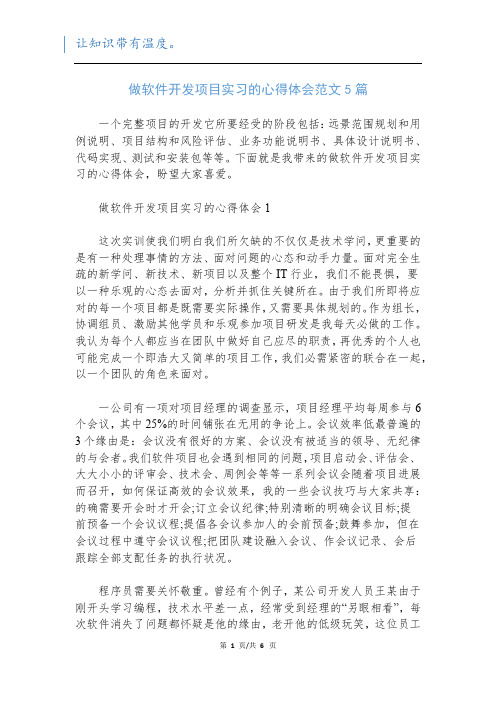
做软件开发项目实习的心得体会范文5篇一个完整项目的开发它所要经受的阶段包括:远景范围规划和用例说明、项目结构和风险评估、业务功能说明书、具体设计说明书、代码实现、测试和安装包等等。
下面就是我带来的做软件开发项目实习的心得体会,盼望大家喜爱。
做软件开发项目实习的心得体会1这次实训使我们明白我们所欠缺的不仅仅是技术学问,更重要的是有一种处理事情的方法、面对问题的心态和动手力量。
面对完全生疏的新学问、新技术、新项目以及整个IT行业,我们不能畏惧,要以一种乐观的心态去面对,分析并抓住关键所在。
由于我们所即将应对的每一个项目都是既需要实际操作,又需要具体规划的。
作为组长,协调组员、激励其他学员和乐观参加项目研发是我每天必做的工作。
我认为每个人都应当在团队中做好自己应尽的职责,再优秀的个人也可能完成一个即浩大又简单的项目工作,我们必需紧密的联合在一起,以一个团队的角色来面对。
一公司有一项对项目经理的调查显示,项目经理平均每周参与6个会议,其中25%的时间铺张在无用的争论上。
会议效率低最普遍的3个缘由是:会议没有很好的方案、会议没有被适当的领导、无纪律的与会者。
我们软件项目也会遇到相同的问题,项目启动会、评估会、大大小小的评审会、技术会、周例会等等一系列会议会随着项目进展而召开,如何保证高效的会议效果,我的一些会议技巧与大家共享:的确需要开会时才开会;订立会议纪律;特别清晰的明确会议目标;提前预备一个会议议程;提倡各会议参加人的会前预备;鼓舞参加,但在会议过程中遵守会议议程;把团队建设融入会议、作会议记录、会后跟踪全部支配任务的执行状况。
程序员需要关怀敬重。
曾经有个例子,某公司开发人员王某由于刚开头学习编程,技术水平差一点,经常受到经理的“另眼相看”,每次软件消失了问题都怀疑是他的缘由,老开他的低级玩笑,这位员工会有怎样的表现就可想而知了。
经理通过这种手段能够迫使这一位自动辞职吗?非也,这位员工后来工作特别不负责任,把代码写得既长又重复,且在代码中留下大量的隐患,此时,经理却反而不敢过份得罪他了(否则,留下的巨量代码很难维护)。
软件开发实习总结5篇

软件开发实习总结5篇篇1时光荏苒,转眼我已经在软件开发领域实习了三个月。
这段时间里,我经历了从零基础到逐渐掌握软件开发技能的过程,也深刻体会到了软件开发行业的艰辛与乐趣。
下面,我将从实习经历、所学知识与技能、问题与不足以及未来规划四个方面进行总结。
一、实习经历在实习期间,我主要参与了公司多个项目的开发工作,包括后端接口设计、数据库优化、项目文档编写等。
通过这些实践,我逐渐掌握了软件开发的基本流程和关键技术,并深刻认识到了团队协作的重要性。
在项目开发过程中,我积极与团队成员沟通交流,共同解决项目中遇到的问题。
同时,我也注重项目文档的编写,以确保项目的可维护性和可扩展性。
在这个过程中,我不仅锻炼了自己的编程能力,还提升了自己的团队协作和沟通能力。
二、所学知识与技能在实习期间,我学到了许多宝贵的软件开发知识和技能,包括:1. 编程基础:通过学习数据结构和算法,我提高了自己的编程基础,能够更好地设计和实现软件系统。
2. 后端开发:我掌握了多种后端开发框架和技术,并能够独立设计和开发后端接口。
3. 数据库优化:我学会了如何对数据库进行优化,以提高系统的性能和响应速度。
4. 项目文档编写:我掌握了如何编写清晰、准确的项目文档,以确保项目的可维护性和可扩展性。
三、问题与不足在实习过程中,我也遇到了一些问题和不足,主要表现在以下几个方面:1. 实践经验不足:虽然我在实习期间参与了很多项目,但仍然感觉自己缺乏足够的实践经验,尤其是在面对复杂问题时容易手足无措。
2. 技术深度不够:尽管我掌握了一些基础技术和框架,但在深入学习和研究方面还有待加强,尤其是在算法和数据结构方面需要进一步提升。
3. 团队协作能力有待提高:在团队协作中,我仍然存在沟通不畅、协作不够默契等问题,需要进一步加强团队协作能力的训练和提高。
四、未来规划针对以上问题和不足,我制定了以下未来规划:1. 增加实践经验:在未来的学习和工作中,我将继续积极参与项目实践,多动手、多思考,积累更多的实践经验。
软件开发心得体会2篇

软件开发心得体会 (2)软件开发心得体会 (2)精选2篇(一)作为一个软件开发人员,我认为以下是我在软件开发过程中的一些心得体会:1. 深入理解需求:在开始开发之前,对于需求的理解十分重要。
开发人员需要与项目相关人员沟通,确保对需求有清晰的理解。
同时,还应该考虑到未来的扩展需求,以便在开发中考虑到。
2. 规划和设计:在开始开发之前,进行全面的规划和设计非常重要。
这包括制定开发计划、技术选型、架构设计等。
3. 编写可读性强的代码:写出可读性强的代码是一个好的习惯。
可以通过使用有意义的变量和函数名,注释代码等方式增加代码的可读性。
这样不仅方便自己和其他开发人员理解代码,也有利于后续维护和扩展。
4. 持续学习和提高:软件行业发展迅速,新的技术和工具层出不穷。
作为软件开发人员,我们需要不断学习和提高自己的技术能力,以跟上行业的发展潮流。
5. 测试和调试:在开发过程中,测试和调试是至关重要的。
通过测试来验证代码的正确性,并及时调试和修复存在的问题。
6. 团队合作:软件开发往往是一个团队合作的过程,良好的团队合作对于项目的成功至关重要。
与团队成员保持良好的沟通和合作,及时解决问题。
7. 持续优化和改进:软件开发是一个不断迭代和改进的过程。
在开发结束后,我们应该持续关注用户的反馈和需求变化,并进行相应的优化和改进。
总的来说,软件开发是一个复杂而有挑战性的过程。
通过不断学习和积累经验,我们可以不断提高自己的技术能力和开发水平,为项目的成功做出贡献。
软件开发心得体会 (2)精选2篇(二)1. 沟通是关键:在软件开发过程中,与团队成员、项目经理以及客户之间的良好沟通是非常重要的。
只有清晰地传达自己的想法、理解需求并与他人协作,才能确保项目的成功。
2. 需求明确是基础:在软件开发之前,确保对需求有清晰的理解和明确的定义是至关重要的。
在开始编码之前,一定要与客户充分的沟通和协商,确保双方对需求达成了一致。
3. 迭代式开发提高效率:采用迭代式开发方法,可以将大型项目拆分成多个小阶段,每个阶段解决一部分问题。
软件开发实习心得体会2篇

软件开发实习心得体会软件开发实习心得体会精选2篇(一)在软件开发实习期间,我学到了很多关于软件开发的实践经验和技能。
以下是我在实习过程中的心得体会:1. 学习与实践结合:在实习期间,我有机会将在学校学到的理论知识应用到实际项目中。
通过参与项目开发,我能够更深入地理解软件开发的各个环节,如需求分析、设计、编码和测试等。
2. 团队合作:实习期间,我有机会与其他开发人员一起工作,学习如何与团队成员合作,理解项目需求并协作完成任务。
这锻炼了我的沟通和协作能力,也加强了我的团队意识。
3. 代码规范与质量:在实习期间,我学会了编写规范的代码,并注重代码的可读性和可维护性。
我也学到了软件测试的重要性,包括单元测试和集成测试。
这些经验对我的编码能力和代码质量提升有很大帮助。
4. 解决问题的能力:在实习期间,我遇到了很多技术挑战和问题,但通过与同事和上级的讨论和合作,我学到了解决问题的方法和技巧。
我也学会了主动寻找解决方案和学习新的技术知识。
总的来说,软件开发实习期间,我不仅学到了很多实践经验和技能,也提高了自己的职业素养和软技能。
这段实习经历对我的职业发展和未来的工作很有帮助。
软件开发实习心得体会精选2篇(二)在软件开发公司实习的这段时间,我学到了很多宝贵的经验和技能。
以下是我实习的心得体会。
首先,我学会了如何与团队合作。
在软件开发过程中,一个好的团队合作是非常重要的。
我学会了与团队成员沟通交流,共同解决问题,并互相支持和帮助。
通过团队合作,我们能够更快地完成项目,并产生更好的效果。
其次,我学会了如何编写高质量的代码。
在实习过程中,我参与了多个项目,接触到了不同的编程语言和工具。
我学习了编写结构清晰、可读性高、可维护的代码,并熟悉了代码版本控制系统的使用。
这些经验让我更加注重代码质量和规范,提高了我的编程水平。
另外,我也学到了项目管理和时间管理的重要性。
在实习期间,我需要根据项目需求和进度安排自己的工作。
我学会了合理规划时间,设定目标,并按时完成任务。
大学生开发app心得体会
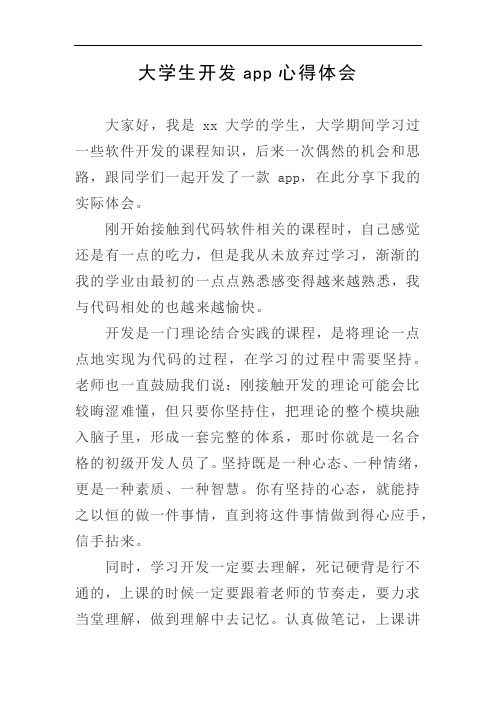
大学生开发app心得体会大家好,我是xx大学的学生,大学期间学习过一些软件开发的课程知识,后来一次偶然的机会和思路,跟同学们一起开发了一款app,在此分享下我的实际体会。
刚开始接触到代码软件相关的课程时,自己感觉还是有一点的吃力,但是我从未放弃过学习,渐渐的我的学业由最初的一点点熟悉感变得越来越熟悉,我与代码相处的也越来越愉快。
开发是一门理论结合实践的课程,是将理论一点点地实现为代码的过程,在学习的过程中需要坚持。
老师也一直鼓励我们说:刚接触开发的理论可能会比较晦涩难懂,但只要你坚持住,把理论的整个模块融入脑子里,形成一套完整的体系,那时你就是一名合格的初级开发人员了。
坚持既是一种心态、一种情绪,更是一种素质、一种智慧。
你有坚持的心态,就能持之以恒的做一件事情,直到将这件事情做到得心应手,信手拈来。
同时,学习开发一定要去理解,死记硬背是行不通的,上课的时候一定要跟着老师的节奏走,要力求当堂理解,做到理解中去记忆。
认真做笔记,上课讲的内容太多,不可能全部记住,所以笔记很关键,笔记不是把老师的所讲所写照搬下来,而是要根据自己的理解去找出重点,难点。
还有,对于软件开发的学习,若不及时复习,后果一样。
课后要整理笔记,从而发现今天有哪些内容是自己不清楚的,一定要去搞清楚,知识是一天天积累的,不能想着一会再说,明天再说!每天的作业都要完成,你能听懂,与能做出来是两码事。
问出最少三个问题,这道题怎么做?为什么这么做?还有没有别的方法?软件开发需要大量的练习,多动手,才会理解的更透彻!一个app软件开发团队中,技术不是万能的,但没有技术是万万不能的!在技术型团队中,技术与人品同等重要。
在软件项目团队中,技术水平是受人重视和尊重的重要砝码。
无论你是做管理、系统分析、设计、编码,还是产品管理、测试、文档、实施、维护,多少你都要有技术基础。
这是我在学习中的一点心得体会,希望能够帮助到各位同学,祝大家毕业后都能找到一份满意的工作,活出自己的精彩!。
实践感悟:软件开发实习心得与反思分享总结

实践感悟:软件开发实习心得与反思分享总结在大学的课程设置中,软件开发实习是一门非常重要的课程。
通过实习,学生能够将之前学到的理论知识应用于实践中,提升自己的实际操作能力,并且更好地了解软件开发行业的工作环境和要求。
在我完成软件开发实习的过程中,我积累了许多宝贵的经验并且反思自己的不足之处,现在我将和大家分享我的实践感悟。
首先,实践确实是检验理论的最好方式。
我们可以在课堂上学到很多关于软件开发的知识,但是只有亲自动手去实践,才能真正理解这些概念和技术。
在我的实习中,我发现通过阅读文档和书籍学习的知识是不够的,需要通过编写代码来加深理解。
只有实践才能让我真正领会到软件开发的本质和实际操作中的问题,这对于我的职业发展至关重要。
其次,与团队合作是软件开发中不可或缺的一部分。
在我的实习中,我有幸加入了一个优秀的软件开发团队,我深刻体会到了团队合作对于项目的重要性。
团队中的成员都有各自的专长,我们可以互相学习和借鉴,共同解决问题。
我学会了与团队成员进行有效的沟通和协作,在项目周期中我们互相支持、取长补短。
每个人都做好自己的本职工作,整个团队的效率和成果都得到提高。
同时,在团队合作中,我认识到了重视自己的贡献和价值。
虽然作为一个实习生,我的经验和技术水平相对于其他团队成员来说是有限的,但我仍然努力发挥自己的优势,提供自己独特的见解和解决方案。
我学会了发表自己的观点和建议,尽管有时也会被否定,但是这并不妨碍我继续努力。
每个人都有自己的价值,只要努力学习和锻炼,就能够在团队中发挥重要作用。
在实习过程中,我也发现了一些自己的不足之处。
首先,我在代码质量上还有待提高。
有时候,为了按时完成任务,我会急于写出符合要求的代码,但是这样往往会导致代码质量不高,存在一些潜在的问题。
我意识到,写出高质量的代码是一个长期的过程,需要不断地学习和积累。
因此,我制定了一个自我提升的计划,包括学习更多的软件工程原理和最佳实践,并且参与代码审查来提高自己的技术水平。
app开发总结报告范文_工程监理总结报告范文

app开发总结报告范文_工程监理总结报告范文App开发总结报告范文:尊敬的领导:经过半年的努力,我所负责的App开发项目已经顺利完成。
在项目执行期间,我与团队成员紧密合作,克服了各种困难和挑战,最终取得了令人满意的成果。
在此,我向您汇报开发过程和收获的也总结了一些经验和教训,供贵单位参考。
一、项目开发过程:1. 确定需求:在项目开始之前,与需求方充分沟通,详细了解他们的需求和期望,确保开发过程中的目标明确。
2. 技术选型:根据需求和资源情况,我们选择了适合的技术栈和开发工具,确保项目开发的效率和质量。
3. 团队协作:通过制定详细的开发计划和任务分配,确保团队成员在项目中的合作紧密,各自负责的模块可以高效地完成。
4. 迭代开发:由于项目时间紧迫,我们采用迭代开发的方式,先开发出最基本的功能,再逐渐迭代完善其他功能。
二、项目收获:1. 成功上线:经过多次测试和优化,我们的App已经成功上线,并得到了用户的良好反馈。
用户量逐渐增加,用户活跃度也逐步提升。
2. 功能丰富:根据需求,我们实现了App的核心功能,并添加了一些附加功能,提升了用户体验,增加了用户粘性。
三、总结经验:1. 强化需求分析:在项目初期,我们应该对需求进行更加细致和全面的分析,以确保我们能够准确地理解客户的需求,避免后期的不必要修改和调整。
2. 技术升级和学习:App开发技术更新换代迅速,我们应时刻关注技术的发展趋势,及时学习和掌握新的技术,以提升开发效率和质量。
3. 加强沟通与协作:在项目中,团队成员之间的沟通和协作非常重要。
我们应该加强团队配合,提高沟通效率,确保项目能够按时完成。
4. 用户体验至上:App的成功与否,关键在于用户体验。
我们应该从用户的角度出发,不断优化和改进产品,提供更好的用户体验。
四、存在问题及改进措施:1. 开发周期较长:由于对需求的理解和技术选型的不够准确,导致项目开发所花费的时间较长。
下一次开发中,我们会加强需求分析和技术选型,以缩短开发周期。
2018年app开发的心得体会-word范文 (13页)

三、Hello World 程序
1、res/layout/main.xml 代码
<?xml version="1.0" encoding="utf-8"?>
2、gen - 自动生成 R.java 文件,用于引用资源文件(即 res 目录下的数据)
3、assets - 用于放置原始文件,Android 不会对此目录下的文件做任何处理,这是其与 res 目录不同的地方
4、res/drawable - 用于放置图片之类的资源;res/layout - 用于放置布局用的 xml 文件;res/values - 用于放置一些常量数据
android:layout_height="fill_parent"
android:id="@+id/layout"
>
<TextView
android:layout_width="fill_parent"
android:layout_height="wrap_content"
android:text="@string/hello"
本文部分内容来自网络整理,本司不为其真实性负责,如有异议或侵权请及时联系,本司将立即删除!
== 本文为word格式,下载后可方便编辑和修改! ==
app开发的心得体会
篇一:Android学习笔记 总结 初学者必看
- 1、下载文档前请自行甄别文档内容的完整性,平台不提供额外的编辑、内容补充、找答案等附加服务。
- 2、"仅部分预览"的文档,不可在线预览部分如存在完整性等问题,可反馈申请退款(可完整预览的文档不适用该条件!)。
- 3、如文档侵犯您的权益,请联系客服反馈,我们会尽快为您处理(人工客服工作时间:9:00-18:30)。
android:id="@+id/layout"
>
<TextView
android:layout_width="fill_parent"
android:layout_height="wrap_content"
android:text="@string/hello"
9、浏览模拟 SD 卡中的内容
调试程序,在 DDMS 中选择 "File Explorer" ,在其中的 sdcard 目录下就是模拟 SD 卡中的内容
10、查看日志 LogCat
Window -> Show View -> Other -> Android -> LogCat
11、在模拟器中安装/卸载 apk
5、AndroidManifest.xml - Android 程序的清单文件,相当于配置文件,配置应用程序名称、图标、Act(来自: : app开发的心得体会 )ivity、Service、Receiver等
三、Hello World 程序
1、res/layout/main.xml 代码
<?xml version="1.0" encoding="utf-8"?>
android:layout_height="wrap_content" android:text="FrameLayout"></TextView>
介绍
在 Android 中各种布局的应用,以及菜单效果的实现
? 各种布局方式的应用,FrameLayout, LinearLayout, TableLayout, AbsoluteLayout, RelativeLayout
?
为指定元素配置上下文菜单,为应用程序配置选项菜单,以及多级菜单的实现
1、各种布局方式的演示 res/layout/main.xml 代码
// 引用资源文件内的内容作为输出内容
TextView txt1 = (TextView)this.findViewById(R.id.txt);
txt1.setText(this.getString(R.string.hello2));
}
}
Android(2) - 布局(Layout)和菜单(Menu)
// 动态地在指定的容器控件上添加新的控件
TextView txt = new TextView(this);
txt.setText("动态添加控件");
// setContentView(txt);
((LinearLayout)this.findViewById(yout)).addView(txt);
</resources>
3、res/drawable 目录下放置一个名为 icon.png 的图片文件
4、AndroidManifest.xml
代码
<?xml version="1.0" encoding="utf-8"?>
<manifest xmlns:android="/apk/res/android"
<resources>
<string name="hello">layout 直接调用 values 中的字符串</string>
<string name="hello2">编程方式调用 values 中的字符串</string>
<string name="app_name">webabcd_hello</string>
<!--
设置 ID 的方式:ID前加前缀,@+id/
引用资源文件内字符串资源的方式:指定的资源名称前加前缀,@string/
-->
<LinearLayout xmlns:android="/apk/res/android" android:orientation="vertical"
android:layout_width="fill_parent"
package="com.webabcd.hello"
android:versionCode="1"
android:versionName="1.0">
<application android:icon="@drawable/icon" android:label="@string/app_name">
<activity android:name=".Main"
android:label="@string/app_name">
<intent-filter>
<action android:name="android.intent.action.MAIN" />
<category android:name="UNCHER" /> </intent-filter>
6、运行 Android 项目
打开菜单 "Run" -> "Run Configurations" -> New launch configuration,设置启动项目名称,在 Android 选项卡中选择启动项目,在 Target 选项卡中设置模拟器
7、创建/使用模拟 SD 卡
创建 SD 卡,运行类似如下命令:mksdcard -l sdcard 512M d:\android\sdcard.img
2、gen - 自动生成 R.java 文件,用于引用资源文件(即 res 目录下的数据)
3、assets - 用于放置原始文件,Android 不会对此目录下的文件做任何处理,这是其与 res 目录不同的地方
4、res/drawable - 用于放置图片之类的资源;res/layout - 用于放置布局用的 xml 文件;res/values - 用于放置一些常量数据
模拟器中使用 SD 卡,在项目配置的 Target 选项卡的 "Additional Emulator Command Line Options" 框中输入类似如下参数:-sdcard d:\android\sdcard.img
8、配置模拟器
运行类似如下命令:android create avd --name android15 --target 2。或者直接在菜单 "Window" -> "Android AVD Manager" 中配置模拟器
@Override
public void onCreate(Bundle savedInstanceState) {
super.onCreate(savedInstanceState);
// 将指定的布局文件作为 Activity 所显示的内容
setContentView(yout.main);
5、新建 Android 项目
"New" -> Android Project,Project Name - 项目名称;Build Target - 编译项目的 SDK 版本;Application name - 程序名称;Package name - 包名;Min SDK Version - 程序所支持的最低 SDK 版本代号(2 对应 1.1,3 对应 1.5,4 对应 1.6)
-->
<LinearLayout xmlns:android="/apk/res/android" android:orientation="vertical" android:gravity="right"
android:layout_width="fill_parent" android:layout_height="fill_parent">
<!--
FrameLayout - 层叠式布局。以左上角为起点,将 FrameLayout 内的元素一层覆盖一层地显示
-->
<FrameLayout android:layout_height="wrap_content"
android:layout_width="fill_parent">
<TextView android:layout_width="wrap_content"
-->
布局。
orientation - 容器内元素的排列方式。vertical: 子元素们垂直排列;horizontal: 子元素们水平排列
gravity - 内容的排列形式。常用的有 top, bottom, left, right, center 等,详见文档
== 本文为word格式,下载后可方便编辑和修改! ==
app开发的心得体会
篇一:Android学习笔记 总结 初学者必看
Android学习笔记总结
第一步:
Android(1) - 在 Windows 下搭建 Android 开发环境,以及 Hello World 程序
